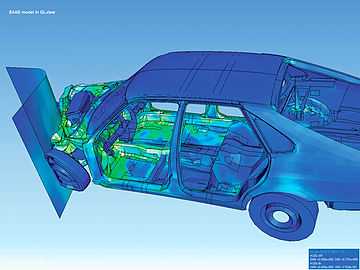Nonlinear finite elements

Visualization of how a car deforms in an asymmetrical crash using finite element analysis.
Welcome to this learning project about nonlinear finite elements!
Introduction
Finite element analysis (FEA) is a computer simulation technique used in engineering analysis. It uses a numerical technique called the finite element method (FEM).
There are many finite element software packages, both free and proprietary. Development of the finite element method in structural mechanics is usually based on an energy principle such as the virtual work principle or the minimum total potential energy principle. *
Project metadata

| Quality resource: this resource is a featured learning resource.
|

| Completion status: this resource has reached a high level of completion.
|

| Educational level: this is a tertiary (university) resource.
|

| Subject classification: this is an engineering resource .
|
- Suggested Prerequisites:
- Time investment: 6 months
- Portal:Engineering and Technology
- School:Engineering
- Department:Mechanical engineering
- Level: First year graduate
Content summary
This is an introductory course on nonlinear finite element analysis of solid mechanics and heat transfer problems. Nonlinearities can be caused by changes in geometry or be due to nonlinear material behavior. Both types of nonlinearities are covered in this course.
Goals
This learning project aims to.
- provide the mathematical foundations of the finite element formulation for engineering applications (solids, heat, fluids).
- expose students to some of the recent trends and research areas in finite elements.
Here's a short quiz to help you find out what you need to brush up on before you dig into the course:
Contents
|
Syllabus and Learning Materials
|
|
|
Assignments, tests and quizzes
Assignments
Tests and Quizzes
|
|
Textbooks and References
Textbooks
- An Introduction to Nonlinear Finite Element Analysis by J. N. Reddy, Oxford University Press, 2004, ISBN 019852529X.
- Nonlinear Finite Elements for Continua and Structures by T. Belytschko, W. K. Liu, and B. Moran, John Wiley and Sons, 2000.
- Computational Inelasticity by J. C. Simo and T. J. R. Hughes, Springer, 1998.
- The Finite Element Method: Linear Static and Dynamic Finite Element Analysis by T. J. R. Hughes, Dover Publications, 2000.
References
- Finite Element Analysis:
- K-J. Bathe (1996), Finite Element Procedures, Prentice-Hall. Useful repository of information on nonlinear finite elements.
- J. N. Reddy (1993), An Introduction to the Finite Element Method, McGraw-Hill. This book is referred to a number of times in one of the texts.
- O. C. Zienkiewicz and R. L. Taylor (2000), The Finite Element Method: Volume 2 Solid Mechanics, Butterworth-Heinemann. Another excellent repository of information of nonlinear finite elements geared toward the Civil Engineers.
- J. Bonet and R. Wood (2008), Nonlinear Continuum Mechanics for Finite Element Analysis, Cambridge University Press. This is a particularly good reference for the general continuum mechanics and kinematics involved, with a detailed discussion on material nonlinearities.
- S. C. Brenner and L. R. Scott (2007), The mathematical theory of finite element methods, vol. 15 of Texts in Applied Mathematics, Springer-Verlag, Classical book on the mathematics foundation of finite element methods.
- Continuum Mechanics:
- Mathematics:
Reading List
- Taylor, R.L., Simo, J.C., Zienkiewicz, O.C., and Chan, A.C.H, 1986, The patch test - a condition for assessing FEM convergence, International Journal for Numerical Methods in Engineering, 22, pp. 39-62.
- Simo, J.C. and Vu-Quoc, L., 1986, A three-dimensional finite strain rod model. Part II: Computational Aspects, Computer Methods in Applied Mechanics and Engineering, 58, pp. 79-116.
- Ibrahimbegovic, A., 1995, On finite element implementation of geometrically nonlinear Reissner's beam theory: Three-dimensional curved beam elements, Computer Methods in Applied Mechanics and Engineering, 122, pp. 11-26.
- Buchter, N., Ramm, E., and Roehl, D., 1994, Three-dimensional extension of non-linear shell formulation based on the enhanced assumed strain concept, Int. J. Numer. Meth. Engng., 37, pp. 2551-2568.
- Rouainia, M. and Peric, D., 1998, A computational model for elasto-viscoplastic solids at finite strain with reference to thin shell applications, Int. J. Numer. Meth. Engng., 42, pp. 289-311.
External links
- Gmsh - GPL'd finite element analyzer
- RecurDyn Full Flexible - RecurDyn’s true Finite Element Method combinded with it´s Multi Body Dynamics - FEMBD mechanical system simulation returns more precise dynamic motion results including stress analysis in one single simulation step. It also features flexible body contacts and non-linear deformations.
Hits this month for the page Nonlinear finite elements - (Hold down CTRL key to display in separate tab in browser)


